
Asian Journal of Atmospheric Environment
Scope & Guideline
Exploring Innovative Solutions for Environmental Challenges
Introduction
Aims and Scopes
- Air Quality Monitoring and Assessment:
The journal emphasizes studies that assess air quality through various monitoring techniques, including the measurement of particulate matter (PM), volatile organic compounds (VOCs), and other pollutants. This is crucial for understanding the health impacts and regulatory needs in urban and industrial areas. - Impact of Climate Change on Atmospheric Conditions:
Research that explores the effects of climate change on atmospheric phenomena, including temperature variations, precipitation patterns, and extreme weather events, is a core focus. This includes assessing how these changes affect air quality and public health. - Pollutant Source Identification and Apportionment:
A significant area of research involves identifying and apportioning sources of atmospheric pollutants using advanced statistical and modeling techniques. This helps in formulating effective environmental policies and interventions. - Health Risk Assessments Related to Air Pollution:
The journal publishes studies that evaluate the health risks associated with exposure to air pollutants. This includes research on specific pollutants like PM2.5 and their health effects on vulnerable populations. - Innovative Technological Applications:
There is a consistent focus on the development and application of new technologies for atmospheric monitoring and pollution control, including remote sensing, machine learning, and novel air quality sensors.
Trending and Emerging
- COVID-19 Related Air Quality Research:
A noticeable increase in studies examining the impact of the COVID-19 pandemic on air quality has emerged, particularly in relation to lockdown measures and their effects on pollutant levels across various regions. - Machine Learning and Data-Driven Approaches:
There is a growing trend towards utilizing machine learning and advanced statistical techniques for predicting air quality and analyzing environmental data. This reflects a shift toward more data-intensive methodologies that can handle complex atmospheric interactions. - Microplastics and Emerging Pollutants:
Research focusing on microplastics and other emerging pollutants is gaining traction, indicating a broader concern for new types of contaminants that affect both human health and environmental integrity. - Integrated Climate and Air Quality Assessments:
Studies that integrate climate change impacts with air quality assessments are on the rise, highlighting the interconnectedness of atmospheric phenomena and the need for comprehensive approaches to environmental management. - Public Health and Air Quality Nexus:
There is an increasing emphasis on the link between air quality and public health, with a focus on assessing health risks and developing interventions to protect vulnerable populations, which aligns with global health objectives.
Declining or Waning
- Traditional Industrial Pollution Studies:
Research focused solely on traditional industrial pollution sources, such as emissions from coal-fired power plants, is becoming less prominent as newer studies adopt more integrated approaches that consider multiple sources and impacts. - Static Air Quality Models:
The reliance on static or traditional air quality models is waning in favor of dynamic and machine learning-based predictive models. This shift reflects a growing recognition of the limitations of older methodologies in capturing complex atmospheric interactions. - Historical Emission Inventory Studies:
While still important, studies that primarily focus on historical emissions inventories without integrating them into current modeling or policy discussions are becoming less frequent, as researchers seek to connect past data with present and future implications.
Similar Journals
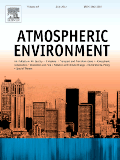
ATMOSPHERIC ENVIRONMENT
Pioneering insights into atmospheric processes and environmental health.ATMOSPHERIC ENVIRONMENT is a premier journal dedicated to advancing the field of atmospheric science and environmental studies, published by Pergamon-Elsevier Science Ltd in the United Kingdom. With an impressive impact factor and recent rankings placing it in the Q2 quartile for Atmospheric Science and Q1 for miscellaneous Environmental Science, it stands as a leading source of high-quality research articles that bridge the gap between atmospheric phenomena and environmental issues. The journal, which has been disseminating significant findings since its inception in 1972, emphasizes an interdisciplinary approach, inviting contributions that address the pivotal challenges facing our atmosphere today. Although it does not currently offer open access options, the journal remains accessible through various academic platforms, ensuring that the latest research reaches its vast audience of researchers, professionals, and students who are striving to deepen their understanding of atmospheric processes. With a robust scope that encompasses a range of topics from climate change to air quality management, ATMOSPHERIC ENVIRONMENT is essential reading for anyone committed to fostering sustainable environmental practices and innovative scientific research.

Atmospheric Environment-X
Exploring the intersection of air quality and climate science.Atmospheric Environment-X, published by Elsevier Science Ltd, is a premier, open-access journal dedicated to advancing our understanding of atmospheric science and environmental disciplines. Since its inception in 2019, the journal has established itself as a critical platform for disseminating high-quality research, evident by its impressive Scopus rankings—39th out of 233 in General Environmental Science and 27th out of 148 in Atmospheric Science, placing it within the top quartiles of its fields. Operating from the United Kingdom, Atmospheric Environment-X aims to bridge the gap between fundamental research and practical applications, addressing pressing issues related to air quality, climate change, and environmental sustainability. With its commitment to open access, the journal encourages broad accessibility of knowledge, ensuring that cutting-edge research reaches a global audience of researchers, professionals, and students eager to contribute to the field. Join us as we explore the complexities of our atmosphere and its critical interactions with the environment through groundbreaking studies published up to 2024.
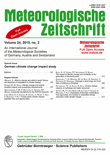
METEOROLOGISCHE ZEITSCHRIFT
Illuminating the Science of Weather PatternsMETEOROLOGISCHE ZEITSCHRIFT is a distinguished academic journal dedicated to the field of meteorology and atmospheric sciences, published by E SCHWEIZERBARTSCHE VERLAGSBUCHHANDLUNG. With an ISSN of 0941-2948 and an E-ISSN of 1610-1227, this journal has been an invaluable resource for researchers, professionals, and students since its inception. It has embraced an Open Access model since 2014, promoting wider dissemination of research findings. Based in Stuttgart, Germany, the journal is recognized for its rigorous peer-review process and is currently positioned in the Q3 quartile for Atmospheric Science as per the 2023 category rankings. Additionally, it ranks #97 out of 148 in the Scopus database, placing it in the 34th percentile among Earth and Planetary Sciences. Covering a broad spectrum of topics relevant to meteorology, METEOROLOGISCHE ZEITSCHRIFT serves as a platform for innovative research and theoretical contributions, aiming to advance understanding of atmospheric phenomena and their implications for climate and weather. Researchers and practitioners alike will find valuable insights within its pages, making it a significant asset in the landscape of meteorological scholarship.

ATMOSPHERIC CHEMISTRY AND PHYSICS
Connecting researchers to tackle global atmospheric challenges.Atmospheric Chemistry and Physics is a leading open-access journal published by Copernicus Gesellschaft mbH, dedicated to advancing the understanding of atmospheric processes and their interactions. With an ISSN of 1680-7316 and E-ISSN of 1680-7324, this journal has been a pivotal resource in the field since its inception in 1999. Based in Göttingen, Germany, it covers a broad spectrum of atmospheric science, providing a platform for original research and reviews that help drive innovation and inform policy. Notably recognized as Q1 in the Atmospheric Science category for 2023, it ranks #8 out of 148 in its field according to Scopus, reflecting its high-quality and impactful contributions. With a commitment to open access since 2001, the journal aims to facilitate widespread dissemination of knowledge, making it readily available to researchers, professionals, and students globally. By fostering the exchange of ideas and findings, Atmospheric Chemistry and Physics plays a crucial role in addressing the pressing challenges related to climate change, air quality, and atmospheric processes.

Environmental Science-Atmospheres
Advancing knowledge for a healthier atmosphere.Environmental Science-Atmospheres is an emerging and dynamic open-access journal published by the Royal Society of Chemistry, dedicated to advancing research in the fields of environmental science and atmosphere-related studies. Launched in 2021, this journal serves as an essential platform for disseminating cutting-edge findings that address the complexities of atmospheric phenomena, pollution impacts, and overall environmental health. With a commendable Q2 ranking across various categories including Environmental Chemistry and Pollution, it solidifies its position as a vital resource for researchers, professionals, and students seeking to contribute to the understanding of environmental dynamics. The journal is indexed in Scopus, providing its contributors with significant visibility within the scientific community. Operating under a fully Open Access model since its inception, Environmental Science-Atmospheres ensures that research outputs are freely accessible, fostering collaboration and knowledge sharing essential for tackling global environmental challenges.

Air Quality Atmosphere and Health
Bridging the Gap Between Air Quality and Community HealthAir Quality, Atmosphere and Health is a leading interdisciplinary journal published by Springer, focusing on the intricate relationship between air quality and public health. With roots dating back to 2008, the journal has established itself as a pivotal resource for researchers and professionals in the fields of Atmospheric Science, Health, Toxicology and Mutagenesis, and Pollution Management and Policy, achieving a commendable Q2 ranking across multiple categories in 2023. The journal’s rigorous peer-review process ensures that it publishes high-quality research that addresses contemporary challenges in air quality management and its impact on health outcomes. With no Open Access option, the journal maintains a model that prioritizes valuable insights for subscription holders, making it an essential reference point for advancing knowledge on environmental health issues. The journal is based in the Netherlands and contributes significantly to the understanding of atmospheric pollutants and their effects, evidenced by its strong Scopus rankings, positioning it in the top percentiles of various environmental science categories.
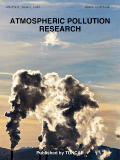
Atmospheric Pollution Research
Pioneering research for a pollution-free future.Atmospheric Pollution Research is a pivotal journal within the realms of Atmospheric Science and Environmental Science, published by the Turkish National Committee on Air Pollution Research and Control (TUNCAP). With an impressive impact, it holds a Q2 ranking in Atmospheric Science and Waste Management and Disposal, and a Q1 ranking in Pollution as of 2023, underscoring its significance and influence in the field. The journal's ISSN 1309-1042 facilitates the dissemination of cutting-edge research addressing contemporary issues in air quality and pollution management. Spanning a convergence of years from 2010 to 2024, it publishes original articles, reviews, and case studies that are essential for advancing knowledge in air pollution and its environmental impacts. Researchers, professionals, and students worldwide will find this journal to be an invaluable resource for staying updated on the latest findings and innovations aimed at mitigating the effects of atmospheric pollution.
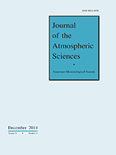
JOURNAL OF THE ATMOSPHERIC SCIENCES
Elevating the Standards of Meteorological ResearchJOURNAL OF THE ATMOSPHERIC SCIENCES, published by the American Meteorological Society, stands as a premier resource for the latest research in atmospheric sciences. With an impressive impact factor and a Q1 ranking in the Atmospheric Science category for 2023, this journal is recognized for its rigorous peer-reviewed articles that contribute to the understanding and advancement of weather, climate, and dynamics of the atmosphere. Established in 1969, the journal has maintained high academic standards and delivers valuable insights spanning over five decades, thus catering to an audience of researchers, professionals, and students alike. Although it does not offer open-access options, it provides critical access through various institutional subscriptions, ensuring that significant research findings are disseminated widely within the scientific community. The journal's address is located at 45 Beacon St, Boston, MA 02108-3693, United States, and it accepts submissions and articles until 2024, continuing its legacy of excellence in atmospheric research.
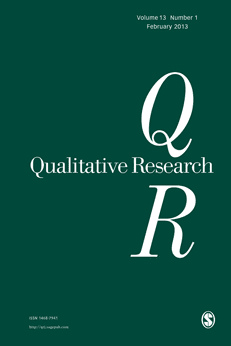
Qualitative Research
Pioneering empirical research that shapes the future of qualitative studies.Qualitative Research, published by SAGE Publications Ltd, is a premier journal that has been at the forefront of the qualitative methodology discourse since its inception in 2001. With an ISSN of 1468-7941 and an E-ISSN of 1741-3109, the journal has established itself as a crucial resource for researchers and practitioners engaged in the fields of History and Philosophy of Science, as well as Social Sciences, where it enjoys a notable Q1 ranking. With an impressive Scopus ranking of #5 in Arts and Humanities and #22 in Social Sciences, this journal aims to disseminate innovative empirical research and theoretical discussions that enrich qualitative inquiry. Researchers, professionals, and students benefit from its rigorous peer-reviewed articles that address critical topics, challenges, and advancements within qualitative research paradigms. Although the journal is not openly accessible, its significant impact factor and distinguished editorial boards ensure that it remains an essential reference for qualitative scholars seeking to deepen their understanding and contribute to the evolution of research methodologies.

Asia-Pacific Journal of Atmospheric Sciences
Unlocking the Secrets of Our AtmosphereWelcome to the Asia-Pacific Journal of Atmospheric Sciences, a leading publication in the field of atmospheric science, published by the Korean Meteorological Society. With an ISSN of 1976-7633 and an E-ISSN of 1976-7951, this journal has been a cornerstone for researchers and practitioners in the atmospheric sciences since its inception in 2008. Recognized for its rigorous peer-reviewed articles, it holds a commendable Q2 quartile ranking in 2023 and is placed at the 51st rank out of 148 in the Earth and Planetary Sciences, reflecting its impact within the community with a 65th percentile. The journal features a broad scope encompassing meteorology, climatology, and environmental sciences, making it an essential resource for scholars and industry experts alike. As an open access journal, it ensures that groundbreaking research is widely accessible, fostering collaboration and innovation across the Asia-Pacific region and beyond. Explore the latest findings and advancements in atmospheric sciences and contribute to the dynamic field of climate research through the journal's engaging content.